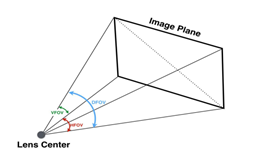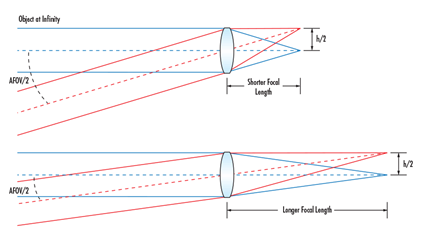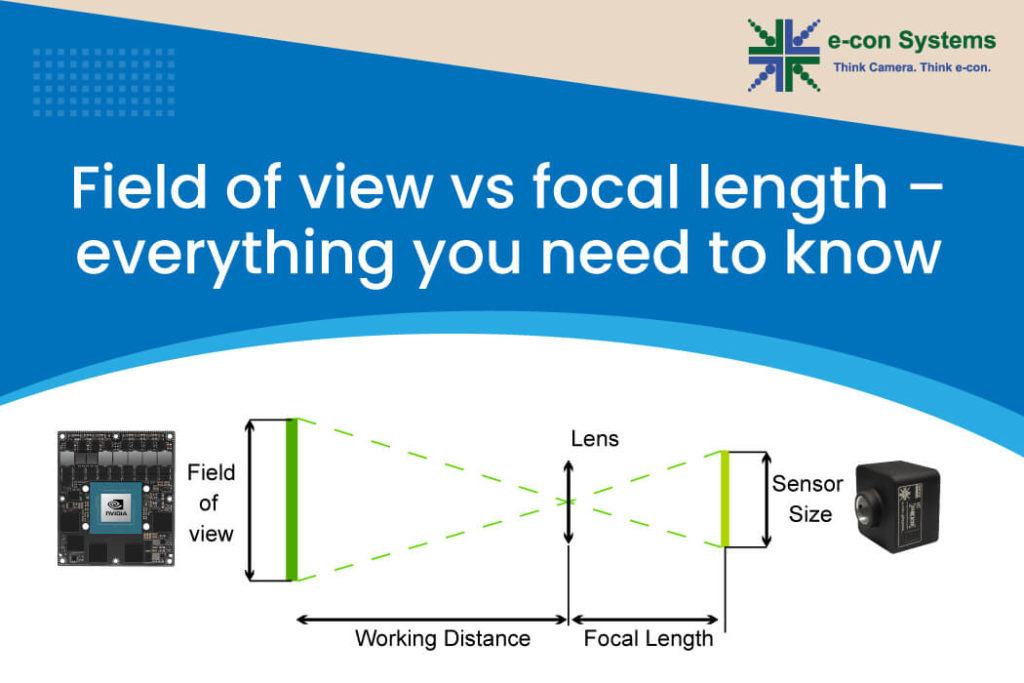This blog post was originally published at e-con Systems’ website. It is reprinted here with the permission of e-con Systems.
Field of view and focal length are two of the most important lens parameters. As simple as they are, not many understand them thoroughly. Learn what they mean, how the two are related, and why it is important to understand the two concepts thoroughly.
Field of view and focal length are two of the most important concepts when it comes to lenses. While focal length is the defining property of a lens, field of view can vary depending on certain other parameters. And when you select a lens for your embedded vision application, you need to make sure that you pick the right one for your sensor such that the desired field of view is achieved.
In this article, we attempt to learn what focal length and field of view are, their differences, and why it is important to understand the two concepts thoroughly when it comes to choosing a lens for your embedded vision application.
What is field of view?
Field Of View is the maximum area of a scene that a camera can focus on/capture. It is represented in degrees. Depending on how you measure it, FOV can be represented either vertically, horizontally, or diagonally as shown in the image below:

Figure 1: Different types of FOV
How to calculate FOV
FOV of a lens is calculated using the below formula:

Where:
- AFOV – Angular Field of View
- HFOV – Width of the object seen through the lens
- Working distance (WD) – Distance between the lens and the object
However, in most cases, the FOV of a lens is expressed using DFOV or Diagonal Field of View. So, you might have to calculate the DFOV value as well. Let us see how that is done.
Usually, the horizontal dimension (which is nothing but the HFOV) and the working distance are given values. Using these, you would be able to calculate AFOV.
Once this is done, invert the formula used to calculate AFOV as given below:

Now DFOV can be calculated by replacing HFOV with it in the above equation. Since AFOV and working distance are known entities, DFOV can be derived using this.
Similarly, VFOV or Vertical Field Of View can be calculated by replacing HFOV with the VFOV value in the same equation.
What is focal length?
Now let’s come to focal length
Focal length is the defining property of a lens. It is the distance between the lens and the plane of the sensor, and is determined when the lens focuses the object at infinity. It is usually represented in millimeters. Its value depends on the curvature and the material of the lens.
Field of view and focal length – how they are related
The following equation illustrates the relationship between field of view and focal length:

Where f is the focal length of the lens and h is the sensor size.
From this equation, it can be understood that the shorter the focal length, the wider the AFOV, and vice versa. This is clearly depicted in the figure below:

Figure 2: Focal Length and AFOV
The significance of understanding the relationship between field of view and focal length
In embedded vision – in most cases – the image sensor is chosen first. This would mean that the choice of lens is heavily determined by the sensor you use (since AFOV depends on the sensor size). For a given sensor size, to achieve a wider FOV, you need to go with a short focal length lens and vice versa. However, since the focal length cannot be made shorter beyond a point, increasing the sensor size also helps to achieve a wider FOV.
Choosing the right lens for your embedded vision application
Picking the right lens considering multiple factors can sometimes be overwhelming. And this is where e-con Systems can help. While integrating our camera modules, we work closely with our customers to help them choose the best-fit lens for their application. We also extend lens fixation and lens mount customization services.
To learn everything about choosing the right lens for your embedded vision system, please visit the article How to choose the right lens for your embedded camera application.
About e-con Systems
e-con Systems has been raising the bar in embedded vision for close to two decades now. With a wide portfolio of MIPI cameras, USB cameras, GMSL2 cameras, FPD-Link III cameras, and GigE cameras, e-con stands true to its vision of enabling machines to see and understand the world better every single day. We have our cameras deployed in more than 300 customer products and have shipped over 2 million cameras globally.
So if you are looking for help in picking and integrating the right camera into your embedded system, please don’t hesitate to reach out to us at [email protected]. Meanwhile, you could browse through our complete portfolio of cameras here.
Prabu Kumar
Chief Technology Officer and Head of Camera Products, e-con Systems


